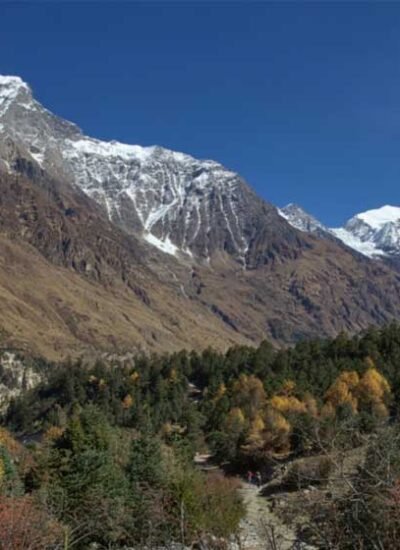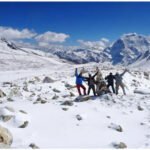The Manaslu Circuit trek is nestled in the lap of Mount Manaslu, the world’s eighth-highest peak. It is much more than just a trek, it’s a wholesome spiritual, cultural, and peaceful experience. You make your way through the colorful prayer flags, ancient stone chortens, and decades and centuries-old Buddhist monasteries. The Buddhist culture and the life you witness here are the spirits of centuries-old traditions.
The Manaslu Circuit trek is the less-walked route in the west-central region of Nepal. This trek invites trekkers into the soul epitome of Buddhist culture, which is also influenced by the Tibetans. The remote villages echo with the praying chants. The pleasant wind makes the prayer wheels spin with its rhythm. You’ll pass through a dozen scared shrines and yak herds.
Manaslu Circuit trek is the perfect balance of natural beauty and an authentic cultural experience. The best way to do this trek is through a well-organized and culturally immersive package like the Manaslu Circuit Trek, offered by Mission Himalayas. Mission Himalayas is a company praised for years now for its precise knowledge, trusted guides, and excellent service.
A Trail Less Traveled, Rich with Spirit
We all know about the famous Everest and Annapurna trekking trails. They are both awesome but way busier. Meanwhile, the Manaslu Circuit trek is completely untouched and maintains its raw beauty. The Manaslu region is a restricted area. It does require a special permit, naturally limiting the number of trekkers and helping to preserve its cultural integrity.
Making your way through the Buddhi Gandaki river, passing terraced fields, gorges, and dense forests, you enter into a majestic world shaped by the traditions of Tibetan Buddhism.
Lho, Samagaon, and Samdo are some of the villages with the most immersive cultural experiences.
In Lho, the settlements are overlooked by a gigantic Buddha Statue. There are many beautifully maintained monasteries that welcomes visitors wholeheartedly. Pungyen Gompa, a tranquil monastery is in Samagaon. It stands beautifully on the side of Manaslu Glacier. The cool mountain breeze makes the prayer flag dance with it and the chants of the monks with a snow-covered mountain view everywhere are unmatched.
Trekking in the Manaslu region offers more than just breathtaking scenery. It gives a look into the lifestyle shaped by faith, resilience, and deep respect for the culture of the Buddhists.
Life Along the Trail: Culture, Hospitality, and Simplicity
Each village along the Manaslu Circuit trek reflects a unique story of its own. Namrung village is adorned with intricate woodwork and shrines that line the pathways. The locals welcome you with a hearty warmth. In Samdo village, it slows to a crawl as trekkers prepare for the enormous passes. The yak herds, people following them, school children, and women working around everybody greet you with a kind smile along the way. It’s like they’re inviting you to adapt their cultures.
The trail is mostly full of Mani walls, stone structures carved with sacred mantras. The sound of the fluttering strings of prayer flags touches your soul. It is believed that they spread goodwill and compassion alongside the wind. The centuries-old monasteries you witness on your way have their routine and the monks are immersed deeply in it. The pure encounters of daily life offer a genuine insight into the region’s culture and spiritual fabric.
With Mission Himalaya Treks, you’ll have local guides offering personal stories and cultural context. Many are from the same region themselves, speaking both Nepali and Tibetan dialects, and their deep roots ensure you connect with the spirit of the land, not just its scenery.
A Trek with Purpose
One of the main cultural highlights of this trek is to spend time at the Pungyen Gompa, a remote monastery surrounded by giant mountain ranges. The monastery is a peaceful place to meditate, reflect on your journey, and talk to monks about their daily routines and beliefs. Also, if you’re trekking towards the end of Autumn, you will witness many local Buddhist festivals, such as Lhosar, the Tibetan New Year. They celebrate these festivals with music, dance, and prayer ceremonies, which is a pure bliss to watch and engage in.
The highest point on the trek is the Larkya La Pass. It’s not just a physical victory, but a spiritual one. This moment might be a deeply emotional moment for them while standing above the clouds, looking towards the endless panoramas of the Himalayan ranges, and reflecting upon the journey that brought them there.
Practical Considerations
Firstly, the best season to trek here is Spring (March to May) and autumn (September to November). During this time, the weather is more stable. The temperature is also moderate with clear skies. Late autumn treks are specifically beautiful, with snow-dusted peaks and the preparations for their upcoming festivals.
The altitude is one of the main things to consider as it reaches up to 5,130 meters. Completing a high-altitude trek in a restricted region like Manaslu requires careful planning and experienced guidance. But companies like Mission Himalaya Treks include acclimatization days to help your body adjust.
Their team of guides is also trained in first aid and altitude sickness response. They’ll carry all the necessary supplies and are also ready for emergency evacuation if required.
Porters they provide carry all your heavier bags, allowing you to enjoy the trail without the burden. The local tea houses you accommodate in may be basic but they are comfortable with hearty local cuisines like dal bhat, Tibetan bread, soups, and noodles to keep you energized throughout the trek.
Known for their professionalism, cultural understanding, companionship, and comfort for decades now, they offer a 14-day Manaslu Circuit Trek package.
Their package costs around USD 1100, which includes a comfortable accommodation in local teahouses, three meals per day, experienced guides and porters, transportation, and all necessary permits.
Final Thoughts: More Than a Trek
The Manaslu Circuit Trek is much more than just walking around busy trails and seeing snow-capped peaks. It’s more about connecting with the culture of the land, its people, and everything. Whether you’re lighting butter lamps in a monastery, sharing tea with your guide, or walking beneath fluttering prayer flags, the spiritual energy of this sacred landscape will surround you.
Make sure to choose a thoughtfully crafted experience like the one offered by Mission Himalaya Treks. Then you can focus on what really is important, embracing Buddhist culture, and discovering your inner rhythm on one of Nepal’s most awe-inspiring journeys.





Leave a Reply